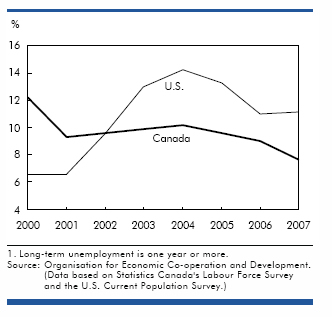Archived Content
Information identified as archived is provided for reference, research or recordkeeping purposes. It is not subject to the Government of Canada Web Standards and has not been altered or updated since it was archived. Please "contact us" to request a format other than those available.
Quick fact
Long-term unemployment among 25 to 54 year-olds in Canada and the U.S.
In 2007, the unemployment rate for Canadians aged 25 to 54 (considered 'core age' by labour analysts) stood at 5.1%. Among the unemployed, 7.7% had been looking for a job for at least a year—the standard definition of 'long term unemployment.' This was a drop from 12.2% in 2000, according to Statistics Canada's Labour Force Survey estimates and the OECD.
The opposite trend was observed in the United States, where long-term unemployment among 25 to 54 year-olds increased to 11.1% from 6.6% over the same period. The highest incidence (14.2%) of long-term unemployment among this group occurred in 2004.
Incidence of long-term unemployment1 among 25 to 54 year-olds in Canada and the U.S.

The overall unemployment rate and the incidence of long-term unemployment can be strongly correlated, but with a lag between a change in unemployment and its effect on long-term unemployment.
In Canada, for example, the overall unemployment trend from 1999 to 2006 was largely reflected in the long-term unemployment trend from 2000 to 2007 among the core working-age population.
Related to this topic:
"Sidelined in the labour market," Perspectives on Labour and Income, Statistics Canada, April 2004.
You need to use the free Adobe Reader to view PDF documents. To view (open) these files, simply click on the link. To download (save) them, right-click on the link. Note that if you are using Internet Explorer or AOL, PDF documents sometimes do not open properly. See Troubleshooting PDFs. PDF documents may not be accessible by some devices. For more information, visit the Adobe website or contact us for assistance.
- Date modified: